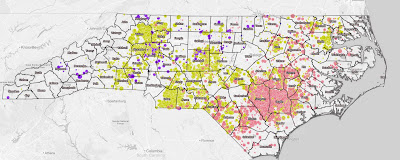A lack of data on the number and location of factory farms "makes regulatory oversight weak and in some cases, nonexistent," Georgina Gustin reports for InsideClimate News. There has been concern in North Carolina over the unknown number of animal carcasses and levels of animal waste that have flooded waterways in the wake of Hurricane Matthew. North Carolina state regulators exempt poultry CAFOs from public records disclosure.
"These massive farms, or CAFOs—concentrated animal feeding operations—can house hundreds of thousands of animals in confined spaces, creating potent volumes of nutrient pollution that have fouled rivers, lakes and oceans," Gustin writes. "Decomposing manure releases toxic chemicals, mostly ammonia and hydrogen sulfide, into the air. Manure stored in lagoons releases methane and nitrous oxide, global warming gases more powerful than carbon dioxide." (Map of North Carolina's animal feed operations created by nonprofit advocacy group Waterkeepers Alliance. For an interactive version click here)
The Environmental Protection Agency estimates "that about 11 percent of the greenhouse gas emissions in the U.S. come from agriculture and about 12 percent of total methane emissions comes from manure management, a rise of about 65 percent since 1990," Gustin writes. EPA, which regulates CAFOs under the Clean Water Act, estimates there are about 19,200 CAFOs, up from 3,600 30 years ago. "Environmental groups say that number is probably higher, largely because the agency has been unable to get reliable and comprehensive information, thanks to patchy state regulation and years of legal pushback from the livestock industry to keep the information from the public."
Last month "a federal appeals court ruled EPA violated the privacy of CAFO operators by releasing information about their farms, which had been requested by three environmental groups through the Freedom of Information Act in 2013," Gustin writes. "The ruling was a victory for the $186 billion meat-and-poultry industry, but environmental groups say it prevents the agency from better regulating CAFOs, at a time when a boom in construction may be on the way."
"These massive farms, or CAFOs—concentrated animal feeding operations—can house hundreds of thousands of animals in confined spaces, creating potent volumes of nutrient pollution that have fouled rivers, lakes and oceans," Gustin writes. "Decomposing manure releases toxic chemicals, mostly ammonia and hydrogen sulfide, into the air. Manure stored in lagoons releases methane and nitrous oxide, global warming gases more powerful than carbon dioxide." (Map of North Carolina's animal feed operations created by nonprofit advocacy group Waterkeepers Alliance. For an interactive version click here)
The Environmental Protection Agency estimates "that about 11 percent of the greenhouse gas emissions in the U.S. come from agriculture and about 12 percent of total methane emissions comes from manure management, a rise of about 65 percent since 1990," Gustin writes. EPA, which regulates CAFOs under the Clean Water Act, estimates there are about 19,200 CAFOs, up from 3,600 30 years ago. "Environmental groups say that number is probably higher, largely because the agency has been unable to get reliable and comprehensive information, thanks to patchy state regulation and years of legal pushback from the livestock industry to keep the information from the public."
Last month "a federal appeals court ruled EPA violated the privacy of CAFO operators by releasing information about their farms, which had been requested by three environmental groups through the Freedom of Information Act in 2013," Gustin writes. "The ruling was a victory for the $186 billion meat-and-poultry industry, but environmental groups say it prevents the agency from better regulating CAFOs, at a time when a boom in construction may be on the way."

No comments:
Post a Comment